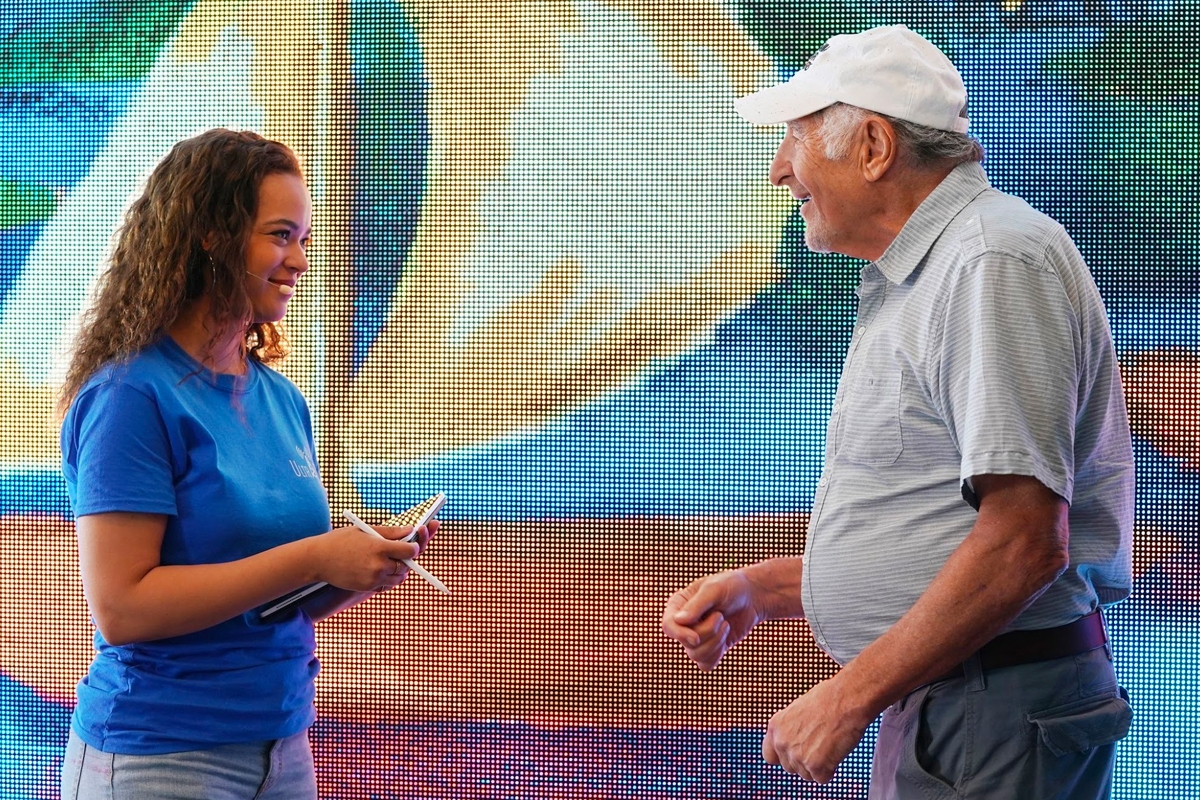When Marvin Samel began telling his father’s life story, he didn’t think he would ever make a film. He had never sold a screenplay or even been on a film set. He was closer to Hollywood, Florida than Los Angeles, and his time was divided between caring for his ailing mother and his twin daughters. But the story of his father, Mordecai, a Holocaust survivor whose stubbornness and frugality became a frequent source of neighborhood hilarity, was begging to be told. Samel made people laugh when he talked about his father at work events — and he also made them think.
To cope with his mother’s Alzheimer’s disease, Samel began writing down “vignettes” from his father’s life. “It was simply as therapy in between 2, 4, 6 AM feedings of our babies,” he said. He never imagining that the stories would cohere into his first feature film, which he co-wrote with Rudy Gaines and Dahlia Heyman.
The film, “iMordecai,” follows a fictionalized version of the Samel family as Marvin (Sean Astin) convinces Mordecai (Judd Hirsch, fresh off his Oscar-nominated turn in Steven Spielberg’s autobiographical film “The Fabelmans”) to finally buy a smartphone; the tongue-in-cheek title refers not to the technology, but to the way Mordecai introduces himself in his Polish accent. Mordecai begins taking smartphone lessons from Nina (Azia Dinea Hale), a store associate and Jewish Community Center volunteer who is grappling with recent revelations of her family’s war-era past. As Mordecai’s artwork and stories of both humor and survival make him more popular with a younger crowd, he begins to leave his declining wife, fellow Holocaust survivor Fela (the inimitable Carol Kane), in the care of others more and more.
While Samel wrote more of his parents’ life stories, his mother’s memory began fading, creating a poignant juxtaposition with the fictionalized version of Fela that Kane brings to life onscreen. Holocaust historians and documentarians have long experimented with the best ways to immortalize someone’s life and story, whether through scholarly work, art or interactive exhibits that preserve survivor testimonies. With “iMordecai,” Samel and his father don’t just tell the story of Mordecai’s escape from Poland to the Soviet Union, where he and an older brother survived the war; they also preserve memories of his mother.
“As the journey of putting the script together is taking hold, my mother is slipping away,” Samel said of his early writing process. “As the dream of bringing this to become a motion picture is coming to fruition, my mother is in her final days.” The film balances these conflicting tones: Mordecai’s joy at connecting to the wider world (and his son) through his smartphone and the wartime nightmares that plague him, Marvin’s concerns for his parents’ welfare and his desire to woo business clients with their entertaining life stories, the development of new life with Marvin’s infant twin daughters and the dissipation of Fela’s cognitive capabilities.
One way that “iMordecai” reconciles the contrasting tones of its story is through animation. The film opens on the animated countryside of Janów Podlaski, Poland, Mordecai’s hometown, where he grows up in relative harmony with non-Jewish neighbors until antisemitism began escalating in the late 1930s. Other flashbacks to life in Janów Podlaski, including the Nazi invasion, are told in animated scenes as well; in one example, Mordecai and his brother accidentally throw a ball into the yard of a non-Jewish neighbor whom they’d believed was friendly, until the man tells the children, “When the Nazis come, I’m going to feed you to Hitler myself.” (This really happened, according to Samel, though he swapped the ages of his father and uncle for narrative purposes.) The “iMordecai” team hadn’t initially planned to animate the past, however: They’d hoped to shoot in Poland before the outbreak of COVID-19, and were worried about how the shift to animation would change the film.
“My fear was my dad was going to turn to me and say, ‘You made a cartoon from my goddamn life?’” Samel said. But co-screenwriter Heyman pitched the animation concept to bring the viewer inside Mordecai’s headspace. The sequences don’t trivialize the past, but instead show how the trauma of the war and Mordecai’s separation from his family live on in his adult psyche.
“What you’re seeing in animation are the distant memories of a 6-year-old child in the form of an 80-something year-old man,” Samel said. The animators at Chaos Emporium Inc. “knew how serious I was in making sure that the animation had a tactile feel that brought the audience even closer to the experience.”
Though he is confident that audiences can relate to both the humor and heartbreak of his family’s story, Samel still sometimes feels like a newcomer in the film world. Mordecai, however, adjusted faster to the hubbub of celebrity. One day at a family lunch, Mordecai wouldn’t put his phone down.
“I’m like, ‘Dad, the kids are here!’” Samel recalled. His father responded, “Shut the hell up. I’m texting with Judd.”
“iMordecai” is out in limited theatrical release on February 24. It will be available to stream on April 11.








